Space pictures! See our space image of the day
Endless stars behind the ISS
Space can be a wondrous place, and we've got the pictures to prove it! Take a look at our favorite space pictures here, and if you're wondering what happened to today in space history don't miss our On This Day in Space video show here!
Endless stars behind the ISS

Thursday, August 29, 2024: Behind a dimly lit portion of the International Space Station (ISS), and enless smattering of stars shines along a stretch of the Milky Way galaxy. This photo, shot from the ISS, was taken using a 1.6 second exposure on a specially programmed, high-sensitivity camera. In the foreground, the station's white-panelled radiators can be seen in front of the megastructure's iconic solar panels.
Polaris almost ready for 'Dawn'
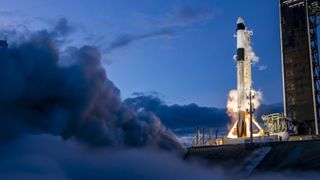
Monday, August 26, 2024: A SpaceX Falcon 9 rocket fires up its nine Merlin engines atop NASA's Pad 39A at the Kennedy Space Center to ensure all is ready for the private Polaris Dawn launch on Aug. 27. This SpaceX photo was captured on Aug. 25 during the brief static-fire test in which the Falcon 9 first stage ignited its main engines briefly. Polaris Dawn is a private space mission financed by American billionaire Jared Isaacman to launch four people on the highest human spaceflight since NASA's Apollo era. The mission will include the world's first private spacewalk. You can follow along with our Polaris Dawn live updates page for more. -- Tariq Malik
Glowing clouds in the dark

Friday , August 23, 2024: Astronomers using the Atacama Pathfinder Experiment, also known as APEX, and the Very Large Telescope Survey Telescope captured this image of glowing red clouds in a star-forming region called RCW 106. The image contains a cosmic mystery: While the glowing red areas contain dense gas for newborn stars, only 1% of the gas will eventually be used to make the new stars "and astronomers don't know why this percentage is so low," the European Southern Observatory wrote in an image description. A new ESO study using APEX and the VLT Survey Telescope has found that denser regions of gas are not more efficient at forming stars, evident in the way the clouds here "fragment into filamentary structures and cores out of which stars will form," ESO wrote. The research is detailed in the Aug. 20 edition of the journal Astronomy & Astrophysics. -- Tariq Malik
A blue moon over a blue Earth
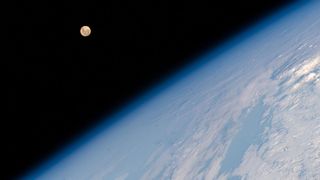
Thursday, August 22, 2024: This months super blue moon was shot by photographers across the world this week, but there were at least a few off the world who got to see it, too. Hung like a golden orb in the black abyss above the bright, blue Earth, the full moon shines in this view from the International Space Station (ISS). Astronauts aboard the ISS captured this image as the station passed over the Indian Ocean, south of Madagascar, according to NASA.
You are here. Also, the rest of us.
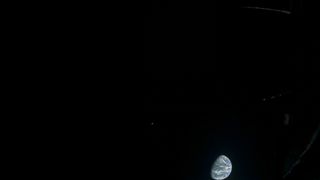
Wednesday, August 21, 2024: The Earth and moon shine against the deep black of space in this stunning view from the European Space Agency's Jupiter Icy Moons Explorer (JUICE) spacecraft during an epic flyby on Aug. 21, 2024 on its way to our solar system's largest planet. In this image, taken by JUICE's Monitoring Camera 1, the Earth appears as a brilliant blue and white orb at bottom while the moon is little more than a bright speck to its left. After the flyby, JUICE headed off to another flyby with Venus in order to slingshot itself on course for Jupiter. - Tariq Malik
Fiery Super Blue Moon
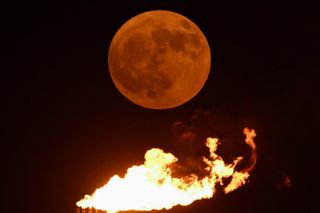
Tuesday, August 20, 2024: The super Blue Moon rises over the flare stacks of an oil field near the port city of Basra in southern Iraq in this photo taken by photojournalist Hussein Faleh for AFP and Getty Image. The August full moon, also called the Sturgeon Moon, was also the third of four full moons for summer 2024, making it a Blue Moon. It occurred as the moon was near perigee, or its closest point to Earth in its monthly orbit, leading NASA to dub the lunar sight a Super Blue Moon. -- Tariq Malik
Related: Supermoon Blue Moon 2024: Top photos from around the world
Get the Space.com Newsletter
Breaking space news, the latest updates on rocket launches, skywatching events and more!
A cosmic treat in orbit

Monday, August 19, 2024: The sweet life in space takes on a whole new meaning as NASA astronauts Tracy Caldwell Dyson and Sunita William create an ice cream sandwich dessert on the International Space Station on Aug. 11 with the help of fresh ingredients that arrived on a Northrop Grumman Cygnus cargo ship this month. The pair even donned makeshift chef hats for the occasion. -- Tariq Malik
Shooting star over devastation

Thursday, August 15, 2024: As wildfires ravage Macedonia, Space.com reader Riste Spiroski sent us this photo, showing a shooting star from the Perseid meteor shower streaking above the smoke. In their own words:
"Tonight at around 12:40 am I snapped a picture of a Perseid Meteor and the wildfire from National Park Galicica - photographed from Village Trpejca, Ohrid. Today is the 10th day since the wildfire started on the mountain.
Tonight, while photographing the fire, a bright meteor suddenly streaked across the sky - I knew I had captured a historic moment. The wildfire is getting worse, slowly approaching populated areas.
Every day, we hear planes flying to the mountain, drawing water from Lake Ohrid and dropping it on the fire.
Tomorrow we expect more planes and people to join the effort to stop it."
A Milky Way marvel over Stonehenge
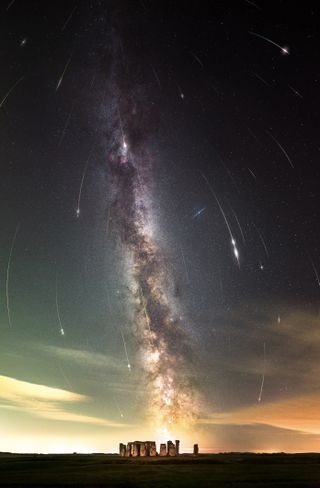
Tuesday, August 13, 2024: Photographer Josh Dury captured an absolutely breathtaking view of the Perseid meteor shower above Stonehenge, U.K.
According to Dury, the image is composed of 43 sub-images of the meteors taken over three and a half hours. "Celestial fireworks baring the connection through time. The ancient debris of Comet Swift-Tuttle; formed at the early dawn of our Solar System. Observed from the ancient palace — chartering the movements of heavenly bodies. A pertinent narrative through senseless time and mystery." he told Space.com in an email. Dury's image is also displayed as NASA's Astronomy Picture of the Day! — Daisy Dobrijevic
Stunning station views
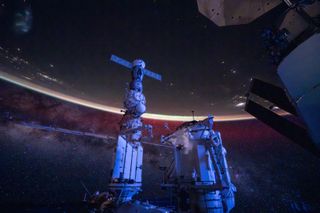
Monday, August 12, 2024: Snapped from low-Earth orbit, aboard the International Space Station (ISS), this stunning photo from NASA astronaut Matthew Dominick shows a portion of Russia's ISS modules against a backdrop of a dark Earth and the Milky Way. In a post on X, formerly Twitter, Dominick wrote, "We received a cargo shipment this week with lots of cool stuff to include some new camera lenses . . . spent a good part of the weekend with a 15mm, T1.8 lens. Made a whole bunch of timelapses. Still looking though 1000s of frames, lots of which have aurora but the milky way in this one stood out."
Clearly, he's putting the new equipment to excellent use.
Astronauts spots geology of Utah
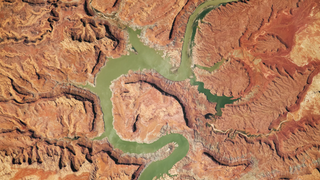
Friday, August 9, 2024: Astronauts aboard the International Space Station (ISS) have captured a stunning image of the Upper Lake Powell region of Utah.
The image shows in incredible detail the geological processes that have shaped this area, including erosion caused by wind and rain and the rising of Earth's surface due to colliding tectonic plates, called "tectonic uplift." The image also features human-created elements such as the 710-foot-high (220-meter) Glen Canyon Dam, one of the largest man-made reservoirs in the U.S.
The image was taken with a Nikon D5 digital camera on July 28, 2024, as the ISS was around 250 miles (408 kilometers) over Earth. It was released by the ISS Crew Earth Observations Facility and the Earth Science and Remote Sensing Unit, Johnson Space Center.
Hubble image shows doomed star in stunning detail
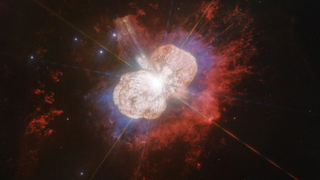
Thursday, August 8, 2024: A stunning image taken by the Hubble Space Telescope in 2019 shows the star Eta Carinae in exquisite detail. If the image was taken five years ago, why are we sharing it today?
Well, we might not get another chance. After all, Eta Carinae is living on borrowed time! The star, which is 100 times as mass as the sun, could explode any day now. Alternatively, the star could have another million years to blow! Either way, Eta Carinae is doomed!
The mass of Eta Carinae means that it is likely to blow in a "classic" supernova explosion. The star, which is one of the most massive in the Milky Way, is also monstrous enough to leave behind a black hole when it dies.
Eta Carinae first announced itself when it erupted with a strange outburst around 170 years ago to become one of the brightest stars in the night sky. Hubble, launched in 1990, has been monitoring Eta Carinae for the last quarter of a century, waiting for it to finally undergo its death throes.
Related: Watch a 180-year-old star eruption unfold in new time-lapse movie (video)
NASA astronaut does cool science on the International Space Station

Wednesday, August 7, 2024: A recent image taken on the International Space Station (ISS) shows NASA astronaut Jeanette Epps processing blood and saliva samples in the station's Harmony module.
After Epps finished with the samples, they were stored in a special freezer an in a unit called the Kubik research incubator so they could be further studied in the future.
As humanity readies itself for the next phase of space exploration and longer stays away from Earth, experiments like this conducted by Epps are vital to undretsanding the impact of space enviroments on various aspects of human biology.
Hubble images a tiny galaxy in the constellation Virgo.

Tuesday, August 6, 2024: NASA has revealed a new image from its long-serving space telescope, Hubble, that shows the faint glow of a small dwarf galaxy.
The galaxy IC 3430 is located around 45 million light years from Earth in the constellation of Virgo. It is an elliptical galaxy, meaning that it is roughly oval-shaped and lacks recognizable features like the spiral arms and dense central bar of stars common to galaxies like the Milky Way.
The heart of IC 3430 is lit with young blue stars, indicating ongoing star formation. Astronomers think this bout of star birth may have been triggered by IC 3430 passing through the dense gas of the Virgo cluster.
Related: Hubble Telescope spots a stunning spiral galaxy shining in the 'Little Lion' (image)
Hurricane Debby seen from space
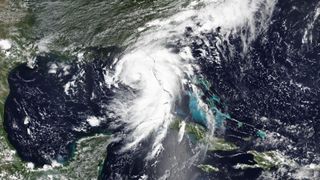
Monday, August 5, 2024: This image taken by the National Atmospheric and Oceanic Administration's NOAA-20 satellite shows Hurricane Debby making landfall along Florida's west coast on Aug. 5, 2024.
At the time the image was taken, NOAA rated Debby as a category 1 hurricane. The storm is predicted to bring potentially historic rainfall and flooding to the South Carolina and Georgia coasts.
NOAA previously predicted that the 2024 hurricane season could see as many as eight to 13 hurricanes develop in the Atlantic due to record-high ocean temperatures.
Read more: 2024 hurricane season should be busy, NOAA says
NASA readies the Europa Clipper's Solar Array
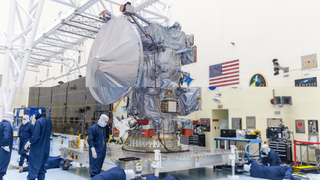
Friday, August 2, 2024: A new image taken on Aug. 1 shows engineers at Kennedy Space Center in Florida working on NASA's Europa Clipper spacecraft.
The team in the Payload Hazardous Servicing Facility is installing the spacecraft's five-panel solar array. The job requires precision alignment of the array and the Europa Clipper.
The launch of the Europa Clipper on its journey to Jupiter and its moons is set for Oct. 10, 2024. When the craft is in space, the solar array will fully deploy, unfolding out to a width of around 100 feet (30 meters), which is about the length of a basketball court.
Once deployed, the array will harvest sunlight powering the Europa Clipper's voyage to the Jovian system, which it is set to enter in 2030. Then, the craft will begin its study of the potentially habitable ocean moon Europa. -- Robert Lea
Dwarfs and Dragons! Hubble is on a quest for dark matter

Thursday, August 1, 2024: A Hubble Space Telescope image shows the dwarf galaxy Draco, located 260,000 light-years from Earth. The long-serving space telescope, which was launched in 1990, spent 18 years studying Draco, measuring the dynamic motions of this dwarf galaxy's stars. The aim of the project was to see if this revealed anything about dark matter, the universe's most mysterious "stuff." Dark matter is conspicuously absent from the image as, due to its lack of interaction with light, it is effectively invisible.--Robert Lea
Archives
Check out our Image of the Day Archives for more awesome photos.
Image of the Day 2020 Archive
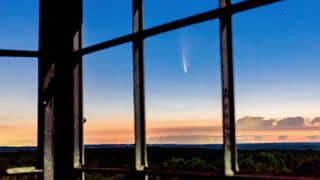
Image of the Day 2019 Archive
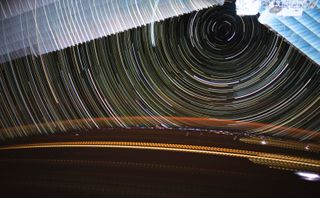
Can't find the date you're looking for? It may have been a weekend or holiday, when we don't normally update our Image of the Day.
Click 'NEXT PAGE' below for July >
July >
Join our Space Forums to keep talking space on the latest missions, night sky and more! And if you have a news tip, correction or comment, let us know at: community@space.com.

Space.com is the premier source of space exploration, innovation and astronomy news, chronicling (and celebrating) humanity's ongoing expansion across the final frontier. Originally founded in 1999, Space.com is, and always has been, the passion of writers and editors who are space fans and also trained journalists. Our current news team consists of Editor-in-Chief Tariq Malik; Editor Hanneke Weitering, Senior Space Writer Mike Wall; Senior Writer Meghan Bartels; Senior Writer Chelsea Gohd, Senior Writer Tereza Pultarova and Staff Writer Alexander Cox, focusing on e-commerce. Senior Producer Steve Spaleta oversees our space videos, with Diana Whitcroft as our Social Media Editor.
-
rod ReplyThe Exoplanets Channel said:The images are truly breath-taking.
The Exoplanets Channel, what star and reddish exoplanet is shown in your picture, looks like about 8" angular separation? I use this site as my canonical reference to exoplanets, The Extrasolar Planets Encyclopaedia Currently 4150 exoplanets are listed. -
swiggly ReplyThe Exoplanets Channel said:The images are truly breath-taking.
My Comet Image:
Neowise -
rod Reply
This is a very good image here. In enjoyed some recent views of NEOWISE using my 90-mm telescope at 40x early, shortly after 0415 EDT. Bifurcated tail obvious too.swiggly said:My Comet Image:
Neowise -
Helio The IOD image for yesterday of the Veil nebula is stunning! The graphics are such that it's almost as if it has an oil film on top. It has both 3D and texture feel to it.Reply -
Astro.Letizia I hope they start posting these daily again! I always start my day off with the newest image but it's been a couple of months now :(Reply